Long Adventure Cagoules
Long adventure cagoules are close to the ultimate rain protection and waterwear. These waterproof pullovers are worn over a base layer of clothes to keep you warm, even when you're soaking wet. Combined with matching rain pants, they are great for all sorts of wet adventures.
Their intended use is for adventure sports with frequent immersion where you want to stay warm. Hence it is fairly easy to swim in them. Good for resistance swim training.
With the introduction of modern waterproof fabrics, the new iteration is more breathable, quieter and generally more comfortable.
History
Cagoules were popular in the 70's but are now making a big comeback, often called ponchos. They are usually hiking capes with long sleeves, closed on the sides, unlike the open poncho. They are wider and longer for better ventilation and cover, so you can enjoy them on a bicycle.
The poncho-esque cagoule was originally developed for British climbers in the early 1960s as a wearable temporary shelter from nasty Scottish weather, with a generous cut from the head down to cover the knees during a downpour. The idea was that you can sit down and pull it over your feet. They were made popular by the Peter Storm company in Britain.
A cagoule, cagoul, kagoule or kagool (from the French cagoule meaning balaklava or hood) is the British English term for a lightweight (usually without lining), weatherproof raincoat or anorak with a hood without a bulky full length zip. It is often shortened to "cag", like in canoeing cag.
The American or Canadian English equivalent is Windbreaker,
the Australian English equivalent is Parka.
In Asia they call them Ponchos,
but they have long sleeves and are closed on the sides like hiking capes.
Wider ones are sold for hiking or as cycling capes.
Design
For wet hikes you may want lightweight cagoules that are easy to swim in but keep you warm and protect you from stings, cuts and scrapes. Worn over soft quick drying clothes, they make fantastic amphibian outfits.
Adventure cagoules are longer than anoraks and reach well below the hips almost to the knees. The better ones go below the knees. This reduces wind chill while you get soaking wet from your activities. Double cuffs seal out moisture.
When you sit down in a wet place they protect your bottom. You can wear them on rainy days when you run around in forests, play on beaches, or jump into lakes, ponds and mud holes.
Outdoor adventure centres provide robust cagoules to guests for wet and muddy activities, including those sports where you go into water repeatedly, or that involve swimming.
Some have a pouch pocket in the chest area with little drain holes to let any water run out.
Small zipped side openings allow quick access to your pants pockets.
Fabrics
While outdoor clothing manufacturers and the media rave about the breathability of Gore-tex or eVent fabrics, the fact is they work poorly for people who cover up their torso with a backpack, shoulder straps, and hip belts. Water vapor can not move across a breathable fabric efficiently under those circumstances.
The coating that makes these clothes breathable, called DWR for “durable water repellent”, rubs off with use. When that happens, most backpackers buy a new jacket, on average every 2-3 years, instead of trying to restore the DWR coating with a product like Nikwax TX Direct.
Alternatively, many hikers and backpackers buy rain jackets that are made with non-breathable fabrics. Many of those rain jackets have pit-zips and other venting features to help reduce internal sweat build up when it rains.
You don’t need to buy an expensive rain jacket for hiking and backpacking
because an inexpensive one will work just as well as one costing an arm and a leg.
Most hikers use rain jackets and ponchos that cost $50 or less for just this reason.
Hood
Adventure cagoules always have an integral hood to protect your head, neck and ears from wind, rain, and sunburn. Without a hood rain would just run off your head and down your collar, soaking your clothes quickly. Same happens when you wear the hood down in the rain. Get used to your hood.
Good fit is important. If it is to large it flaps around in the wind or obstructs your vision. This is even more important when you're swimming as you don't want the hood to fill up with water. A tight fit avoids that.
Better cagoules have a hood with two draw cords, one around the face and the other across the back of the head.
The latter draw cord reduces the overall size of the hood for a better fit.
Some cagoules have a hood or pocket that doubles as a bag into which the rest of the coat is pushed when stowed.
Layers
Rainwear may not keep you dry, but can keep you warm by shielding you from wind and rain. Inside forms a warmer micro-climate. Your goal should be to stay warm and avoid hypothermia.
Think of rain clothes as part of a larger layering system to keep you warm, often in combination with a mid or base layer.
A loose fitting outer layer gives you more freedom to move. Underneath a quick drying fleece pullover and matching pants will keep you warm, as you won't be moving as fast as on usual open water swims. Add robust boots or trekking sandals.
Sports clothes are designed to get wet and remain comfy and functional in the water.
They are the base layer you wear next to the skin.
Most are soft and pleasant, some get itchy.
Sizing
Designed for the rigours of adventure use, cagoules are generously sized to allow layering and maximum freedom of movement. This also provides for better ventilation.
The longer design should reach below the knees to give you better protection when you sit down on damp ground, walk through a waterfall, get splashed on a boat, or similar wet activities. When it rains, sit down and pull it over your legs for a complete shelter.
As full-length rain garments, cagoules are designed to fit over everything. Some even include your back pack. Specialist cagoules can be used as a bivi shelter in an emergency.
No Swimwear
Swimwear is not needed. You can use unlined rain clothes as swimwear, because they dry quicker than shorts or swimsuits, and make good sun protection that doesn't wash off like sun lotion. Save the weight and help protect the environment.
Cost
If you’ve ever bought waterproof hiking equipment you already know it usually comes with a hefty price,
but this doesn't have to be so.
Don't go for expensive technical fabrics.
Simple nylon and polyester is fine, as long as it is breathable.
A good breathable anorak or poncho, rain pants, robust footwear,
and a hooded rain cover for your pack have you prepared for wet days.

Adventure cagoules often have no zips that get blocked by mud and sand during your wet adventures. This also means less bulk and weight. Simply pull the draw strings of the hood to close the top.
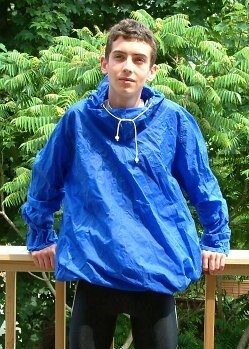
A draw cord at the base of the cagoule allows you to tie it in and raise it up to your waist for better leg movement.
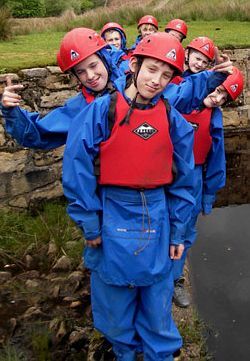
They are well dressed for wild adventures in the water.
Extra Long Cagoule
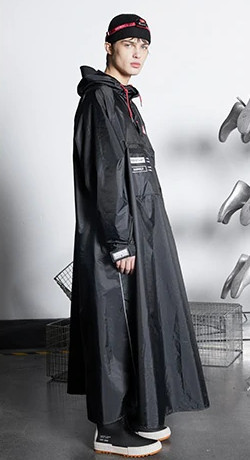
The extra length gives you the best rain cover. Also available in yellow.
We haven't tested it yet, but it looks very promising.
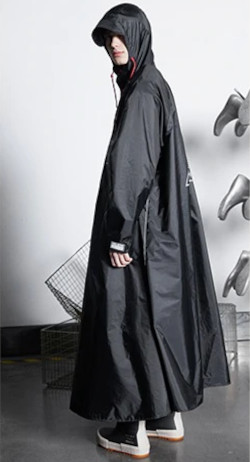
Adventure Cagoule Swim Test
by Lee FungWhile in Thailand I went swimming in a long cagoule with matching unlined Nylon pants. I enjoyed this simple, very comfortable, quick drying swimming outfit with good UV sun protection. The fabric felt soft both wet and dry, on land and in the water. The generous cut allowed for plenty of ventilation. No need to wear anything underneath if it is too hot.
In the water it felt lightweight and pleasant, did not get in the way. It gently hugged my body as I moved forward, or floated loosely around when I stayed in one place. Coming out of the lake, the water ran off quickly and I sat down for lunch. The cagoule and pants felt good on my skin as they dried off in the breeze.

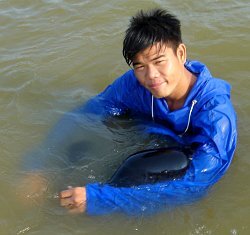
Long swim pants dry fast.
Your Comments
Traditional Long Cagoule
For me personally it has to be an original cagoule. I've seen kids in the water in newer ones and it just does not look right. They are too short and don't always fit well, limiting their swimming skills. The simple long cagoule with a short zip, or no zip, white drawstrings and simple black and white embroidered logo is what really makes these. ~ Denis, London, England
Dozens
I've have over a dozen or so of these anoraks, collected over the last few years, from smocks to three quarter lengths, to multi-coloured ones, bought in and then sold on, but I always revert back to them every so often. Perhaps this is a result of living in an area famous for it's rain. ~ Christine, Cumbria, England
Simplicity
I just love the simplicity of anoraks and cagoules, an ideal layer in the cooler months and great in an unpredictable summer. They have an everlasting cool in my personal opinion, so uncool, it's cool. Reminds me of geography teachers on school field trips. Nice bright layer of nylon over a tweed jacket, that emergency layer that can be thrown on over anything for twenty solid years, or perhaps over a Fred Perry/Lacoste polo as worn by late seventies northern hooligans and mid eighties anti-suss post sportswear casualists. ~ Ronald, Edinburgh, Scotland
Adventure Swim Training
by Sascha in AustriaAdventure swimming in clothes is easy if you practice often. To prepare for my summer adventures, I do regular swim training in my adventure kit. It consists of a long cagoule, matching rain pants, with thermal clothes underneath.
The local pool lets me swim in my clean adventure clothes as long as I wear them in the shower first to rinse them thoroughly. No problem.
For endurance training I only wear a full body Lycra suit, which speeds up my swimming because it streamlines my shape and makes me more aqua-dynamic. It feels nice on my skin and allows me to move swiftly when I swim many lengths in the pool.
For my resistance training I put on my slightly oversized cagoule, made of thin nylon. Front crawl is fairly easy as the cagoule just hugs my body and creates just a bit of drag.
Breaststroke comes up with a lot more resistance. My cagoule reaches below my knees, so when I bring my legs forward it works like a sail, slowing me down. Swimming like this requires a lot more effort.
Lifesaver's backstroke is quite easy as the cagoule just stays put from shoulders to below my knees. Sidestroke is also quite easy. I get a good workout from all of this swim training.
Afterwards I wear all the clothes in the shower to rinse the chlorine out.
Then I shake the water out and wear my cagoule on the way home, ready for my next adventure.
Fun on the Beach
by Alistair, Devon, EnglandOutdoor adventure sports are my passion. I live near the beach and often run down to see what's happening.
In the summer I drive with my friends to outdoor centres where we enjoy survival swimming, canoeing, rafting, and muddy assault courses. There is nothing more exciting than splashing around in open nature. This is extreme fun when you wear the right kit.
To stay warm I wear my long adventure cagoule and pants, made from tough nylon which avoids cuts and bruises. Underneath I wear thermal clothes or a tracksuit or both. Dressed like this I can jump into the water or a mud pit whenever I want.
If I feel like it, I run to the beach for a quick swim or go rock hopping at low tide. Most times I come home soaking wet after my adventures. My cagoule keeps me warm.
